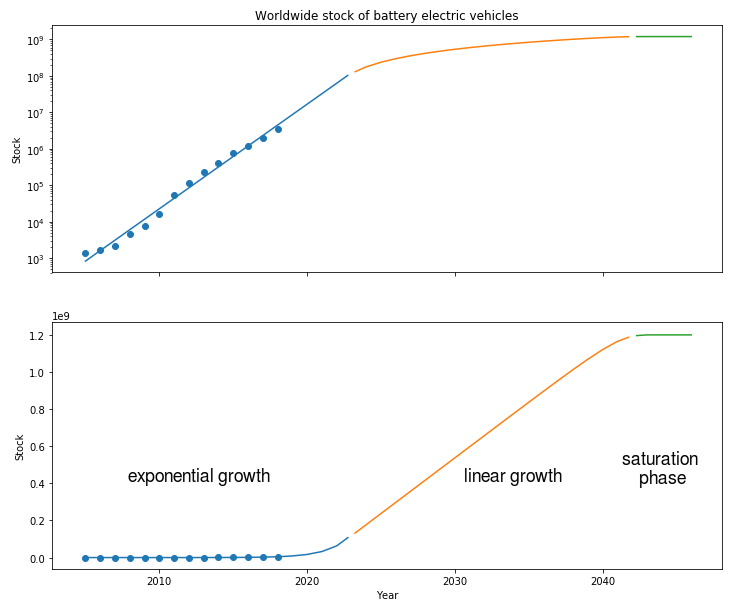I came across an article where the authors used a simple model to forecast the total installed wind and solar power. I decided to do a similar analysis for the electric vehicle market.
Model
The model used in the article1 works as follows: the most direct way to go from point A (no electric cars) to point B (all vehicles are electric) is a straight line. Since you cannot produce electric vehicles equal to the entire demand for new vehicles all at once, an electric vehicle market supply chain must be established. The model identifies three phases:
- An exponential growth phase during which the supply chain develops until its output matches the product replacement rate (as determined by the product lifetime).
- A linear growth phase during which all old products are steadily replaced by newer counterparts.
- The saturation phase where the total number of products no longer changes.
Results
For the exponential growth phase, I used data from the Global EV Outlook 20172, and for the linear phase, I assumed a vehicle lifetime of 20 years. Based on these assumptions, the following result is achieved:
The earliest at which all vehicles in the world can be replaced by electric ones is 2043. That assumes all vehicles that were in the world at 2014 will be replaced by electric vehicles.
Alternative scenarios
What if:
- The total number of vehicles that should be replaced is larger than the current 1.2 billion, say 3 billion: 2044
- Or, what if the vehicle lifetime is longer, say 30 years: 2052
- Or both: 2053
Conclusions
Assuming all vehicles are replaced by electric ones, we have around four years of exponential growth of the electric vehicle market ahead. Around 2023, linear growth begins, and gradually, all internal combustion vehicles are replaced by electric ones, which will occur by 2044. Note that although the market growth seems impressive on the logarithmic plot, on a linear scale, you can see that the electric vehicle market is still small in 2018, at 0.28%.
Also note that the car lifetime has the largest effect on when all vehicles can be replaced. It would, for example, be possible to replace all vehicles earlier than 2044 by artificially lowering the lifetime of a car. In other words, incentivize people to discard their cars and buy an electric one.
-
Nederlands Tijdschrift voor Natuurkunde (Dutch Journal of Physics) Waarom wij wel zonnepanelen maar nog geen kernfusiestroom hebben (Why we have solar panels but no nuclear fusion power) by Niek Lopes Cardozo, Guido Lange, and Gert Jan Kramer (NTvN 83, October 2017, page 350-354) ↩
-
https://webstore.iea.org/global-ev-outlook-2017, table 5 on page 49. ↩
